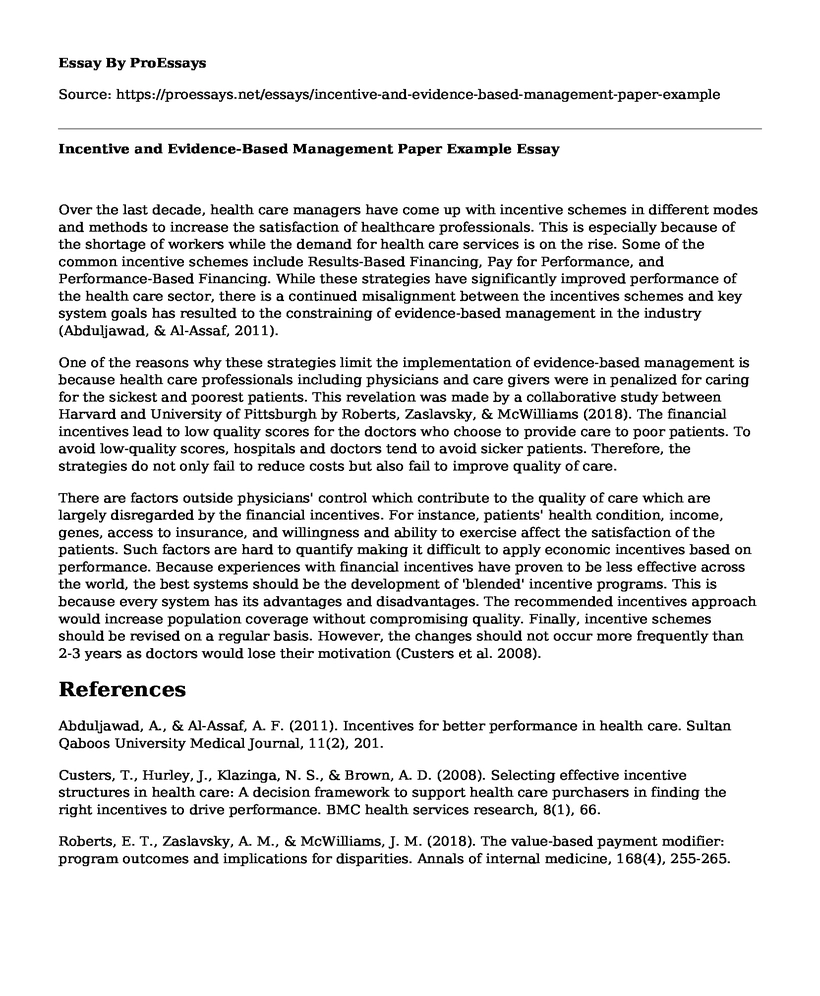Over the last decade, health care managers have come up with incentive schemes in different modes and methods to increase the satisfaction of healthcare professionals. This is especially because of the shortage of workers while the demand for health care services is on the rise. Some of the common incentive schemes include Results-Based Financing, Pay for Performance, and Performance-Based Financing. While these strategies have significantly improved performance of the health care sector, there is a continued misalignment between the incentives schemes and key system goals has resulted to the constraining of evidence-based management in the industry (Abduljawad, & Al-Assaf, 2011).
One of the reasons why these strategies limit the implementation of evidence-based management is because health care professionals including physicians and care givers were in penalized for caring for the sickest and poorest patients. This revelation was made by a collaborative study between Harvard and University of Pittsburgh by Roberts, Zaslavsky, & McWilliams (2018). The financial incentives lead to low quality scores for the doctors who choose to provide care to poor patients. To avoid low-quality scores, hospitals and doctors tend to avoid sicker patients. Therefore, the strategies do not only fail to reduce costs but also fail to improve quality of care.
There are factors outside physicians' control which contribute to the quality of care which are largely disregarded by the financial incentives. For instance, patients' health condition, income, genes, access to insurance, and willingness and ability to exercise affect the satisfaction of the patients. Such factors are hard to quantify making it difficult to apply economic incentives based on performance. Because experiences with financial incentives have proven to be less effective across the world, the best systems should be the development of 'blended' incentive programs. This is because every system has its advantages and disadvantages. The recommended incentives approach would increase population coverage without compromising quality. Finally, incentive schemes should be revised on a regular basis. However, the changes should not occur more frequently than 2-3 years as doctors would lose their motivation (Custers et al. 2008).
References
Abduljawad, A., & Al-Assaf, A. F. (2011). Incentives for better performance in health care. Sultan Qaboos University Medical Journal, 11(2), 201.
Custers, T., Hurley, J., Klazinga, N. S., & Brown, A. D. (2008). Selecting effective incentive structures in health care: A decision framework to support health care purchasers in finding the right incentives to drive performance. BMC health services research, 8(1), 66.
Roberts, E. T., Zaslavsky, A. M., & McWilliams, J. M. (2018). The value-based payment modifier: program outcomes and implications for disparities. Annals of internal medicine, 168(4), 255-265.
Cite this page
Incentive and Evidence-Based Management Paper Example. (2022, Nov 20). Retrieved from https://proessays.net/essays/incentive-and-evidence-based-management-paper-example
If you are the original author of this essay and no longer wish to have it published on the ProEssays website, please click below to request its removal:
- Spiritual Care and Worldviews in Nursing
- International Business and Walmart Paper Example
- Nutrient Intake During Diet-Induced Weight Loss
- How Lack of Knowledge by Nurses Dealing With Dementia Patients Creates a Stressful Working Environment
- The Coronary Artery Disease Paper Example
- Essay Sample on Two Heads: Improving Online Grant Portal for Equity
- University Crisis Communication Plan: A Guide for Officials Paper







